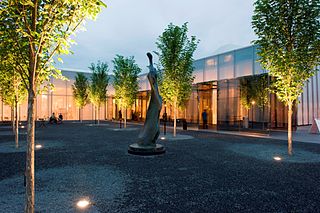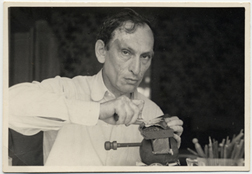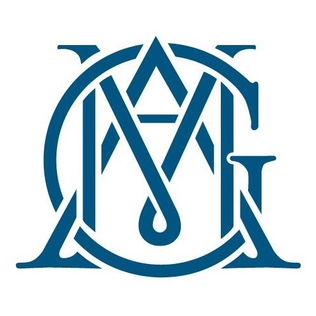Related Research Articles

American Impressionism was a style of painting related to European Impressionism and practiced by American artists in the United States from the mid-nineteenth century through the beginning of the twentieth. The style is characterized by loose brushwork and vivid colors with a wide array of subject matters but focusing on landscapes and upper-class domestic life.

Frederick Childe Hassam was an American Impressionist painter, noted for his urban and coastal scenes. Along with Mary Cassatt and John Henry Twachtman, Hassam was instrumental in promulgating Impressionism to American collectors, dealers, and museums. He produced over 3,000 paintings, oils, watercolors, etchings, and lithographs over the course of his career, and was an influential American artist of the early 20th century.

The Ten American Painters was an artists' group formed in 1898 to exhibit their work as a unified group. John Henry Twachtman, J. Alden Weir, and Childe Hassam were the driving forces behind the organization. Dissatisfied with the conservatism of the American art establishment, the three artists recruited seven others from Boston, New York City, and elsewhere on the East Coast, with the intention of creating an exhibition society that valued their view of originality, imagination, and exhibition quality. The Ten achieved popular and critical success, and lasted two decades before dissolving.
The Southeastern Center for Contemporary Art (SECCA) is a multimedia contemporary art gallery in Winston-Salem, North Carolina.
Events from the year 1935 in art.

The North Carolina Museum of Art (NCMA) is an art museum in Raleigh, North Carolina. It opened in 1956 as the first major museum collection in the country to be formed by state legislation and funding. Since the initial 1947 appropriation that established its collection, the Museum has continued to be a model of enlightened public policy with free admission to the permanent collection. Today, it encompasses a collection that spans more than 5,000 years of artistic work from antiquity to the present, an amphitheater for outdoor performances, and a variety of celebrated exhibitions and public programs. The Museum features over 40 galleries as well as more than a dozen major works of art in the nation's largest museum park with 164-acres (0.66 km2). One of the leading art museums in the American South, the NCMA recently completed a major expansion winning international acclaim for innovative approaches to energy-efficient design.

The Old Lyme Congregational Church is located in Old Lyme, Connecticut. The church is noted as a favorite subject of Old Lyme Art Colony painters. It is affiliated with the United Church of Christ.

Ilya Schor was an artist, a painter, jeweler, engraver, sculptor, and renowned artist of Judaica.

Robert Gwathmey was an American social realist painter. His wife was photographer Rosalie Gwathmey and his son was architect Charles Gwathmey.

The Georgia Museum of Art is an art museum in Athens, Georgia, United States, associated with the University of Georgia (UGA). The museum is both an academic museum and, since 1982, the official art museum of the state of Georgia. The permanent collection consists of American paintings, primarily 19th- and 20th-century; American, European and Asian works on paper; the Samuel H. Kress Study Collection of Italian Renaissance paintings; growing collections of southern decorative arts and Asian art; and a strong collection of works by African American artists. It numbers more than 17,000 works, growing every year.

The Monterey Museum of Art (MMA) an art museum located in Monterey, California. It was founded in 1959 as a chapter of the American Federation of Arts. The Monterey Museum of Art collects, preserves, and interprets the art of California from the nineteenth century to the present day. Notable holdings celebrate the heritage of Northern and Central California, and especially for early California images from the Carmel Art Colony.

Cliff Rock - Appledore is an oil painting by American artist Childe Hassam, painted in 1903. It is part of the permanent collection at the Indianapolis Museum of Art.
Pinkney Near was the curator of the Cincinnati Museum of Art and afterward the curator of the Virginia Museum of Fine Arts for thirty years. He was responsible for the VMFA's acquisition of many treasured works of art, including arranging for the museum to purchase from John Lee Pratt the Francisco Goya portrait of General Nicolas Guye and from the collection of Count Karol Lanckoroński of Vienna, Austria, a rare marble sarcophagus dating to the 2nd century B.C. The Guye portrait was long believed to be the most valuable single work of art in the VMFA's collection. The Goya portrait of General Guye is on view prominently in the posthumously created Pinkney Near Gallery at the VMFA.

Lyme Art Association (LAA) is a nonprofit art organization established in 1914, with roots going back to 1902. The LAA maintains a historic art gallery located at 90 Lyme Street in the Old Lyme Historic District, Old Lyme, Connecticut. The gallery was built in 1921 to a design prepared by the architect and artist Charles A. Platt. The association holds exhibitions throughout the year, featuring the work of member artists as well as visiting ones, with an emphasis on representational art The building has a north-light studio, where the association conducts classes year-round.
The New England Watercolor Society, originally named the Boston Watercolor Society, is an artist-run organization formed to promote and exhibit work by watercolor painters. It was also at one time known as the Boston Society of Watercolor Painters. It is headquartered in Plymouth, Massachusetts.

The Water Garden is a 1909 painting by the American Impressionist painter Childe Hassam. Done in oil on canvas, the painting is in the Metropolitan Museum of Art in New York.

Louis Rémy Mignot was an American painter of Catholic descent. Associated with the Hudson River School of landscape artists, his southern US heritage and the influence of his time spent in Europe gave him a distinct style within that group, in painting vegetation and atmospheric effects.
The Precious Legacy: Judaic Treasures from the Czechoslovak State Collections was one of the names for a travelling exhibition of Czech Jewish art and ritual objects that opened at The Whitworth in Manchester, in 1980. It subsequently toured the United States and Canada from 1983 to 1986. In 1990, part of the show was brought to Israel for a joint exhibition with the permanent collection of the Israel Museum. The travelling exhibition was relaunched in 1998 for a two-year tour of Sweden, New Zealand, and Australia.

Elizabeth Bradford is an American artist living in Davidson, North Carolina, best known for her large-scale paintings of landscapes. Her works have been widely exhibited throughout the southeastern United States and are collected in museums and collections, both private and corporate, across the country.

The Silver Veil and the Golden Gate is a late period, coastal landscape painting by American Impressionist Childe Hassam. Completed in 1914 during one of his visits to California, the piece depicts the Golden Gate Strait, a narrow passage connecting the San Francisco Bay to the Pacific Ocean, as seen near Sausalito. The "silver veil" refers to the iconic San Francisco fog that frequently envelops the region.
References
- ↑ "Curators". North Carolina Museum of Art. 2020. Archived from the original on 2 May 2020. Retrieved 26 April 2020.
- 1 2 Fecho, Susan (8 February 2012). "Barton Galleries 2012 Scholastics Art Award". issuu.com. Retrieved 26 April 2020.
- ↑ "Ann Roth". The Mahler Fine Art. 2020. Retrieved 26 April 2020.
- 1 2 3 ElGenaidi, Deena (27 December 2018). "Tate Acquires Sylvia Pankhurst's Watercolors, and North Carolina Museum of Art Acquires William Wetmore Sculpture". hyperallergenic.com. Retrieved 26 April 2020.
- 1 2 3 Grimes, William (9 February 1997). "A Landscape Master Lost in the Shadows". The New York Times . p. 41. Retrieved 6 October 2010.
- 1 2 3 Manthorne, Katherine E.; Coffey, John W. (1996). The Landscapes of Louis Rēmy Mignot: A Southern Painter Abroad. Raleigh, North Carolina: North Carolina Museum of Art. ISBN 1-56098-702-2.
- ↑ Goins, Brandon (5 December 2018). "NCMA Judaic Gallery Tour". North Carolina Department of Natural and Cultural Resources. Retrieved 26 April 2020.
- ↑ Coffey, John (12 July 2013). "Steinhardt Collection of Judaica". NC Art Museum. Archived from the original on 22 April 2019. Retrieved 26 April 2020.
- ↑ "Provenance Research". North Carolina Museum of Art. Archived from the original on 26 May 2020. Retrieved 26 April 2020.
- ↑ See, Sebastian (22 July 2016). "Childe Hassam loved, and painted, the Isles of Shoals". Boston Globe. Retrieved 26 April 2020.
- ↑ Menconi, David (15 August 2017). "Are confederate statues considered art, or history worth preserving?". News and Observer. Retrieved 26 April 2020.